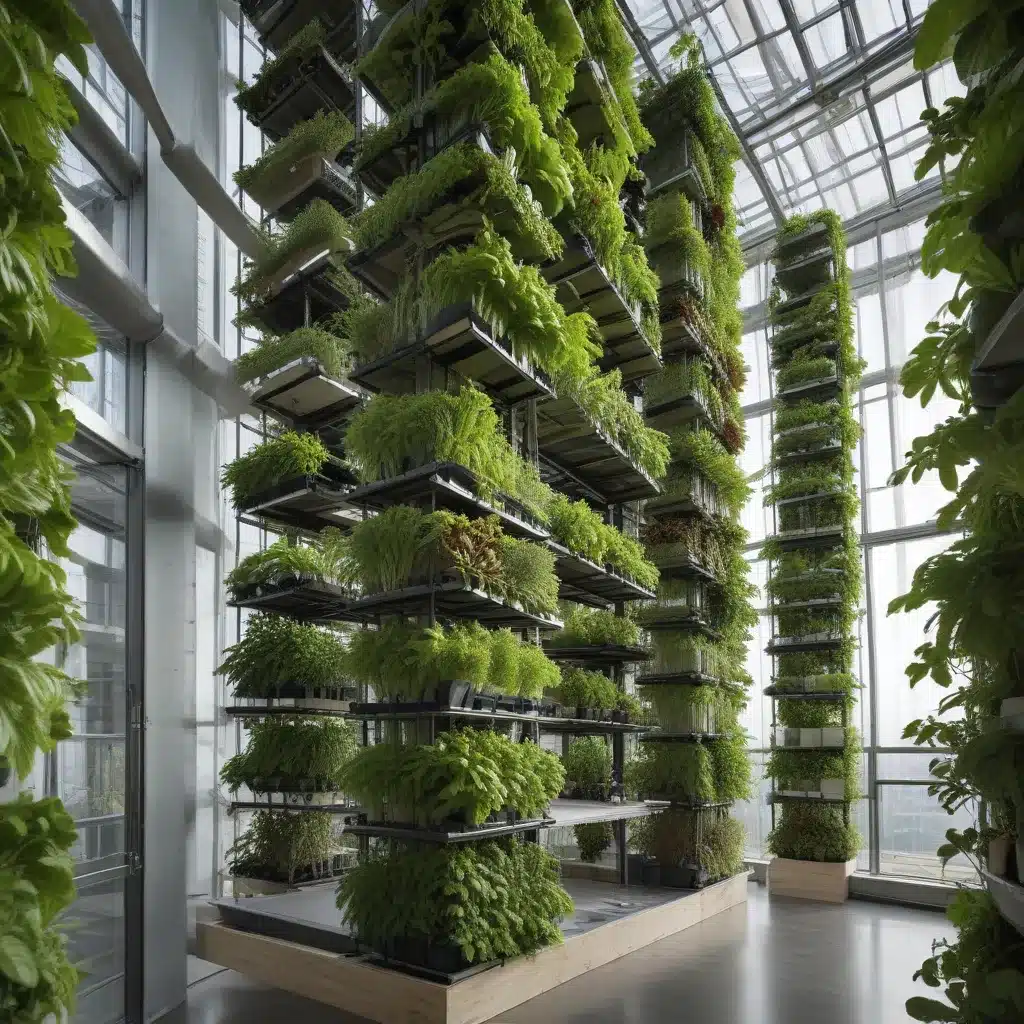
The shift towards more sustainable cities is a pressing global challenge, requiring innovative solutions that address the interlinked domains of food, energy, and the built environment. Urban agriculture, particularly vertical farming, has emerged as a promising strategy to improve local food security, reduce the environmental footprint of agriculture, and integrate food production seamlessly into the urban fabric. By harnessing the potential of sustainable architecture, cities can strategically incorporate vertical farming systems into building designs, creating symbiotic relationships that enhance resource efficiency and environmental performance.
Principles of Sustainable Design
At the heart of this integrated approach lies the principles of sustainable design. Architects and urban planners are increasingly embracing holistic design strategies that prioritize energy efficiency, renewable energy integration, and the circular use of resources. This includes techniques such as passive solar design, green roofs, and the strategic placement of openings to maximize natural ventilation and daylighting. By aligning the built environment with the principles of sustainability, cities can create the necessary infrastructure to support the integration of urban agriculture.
Energy-Efficient Building Techniques
One of the key challenges in vertical farming is the substantial energy demand required to maintain the optimal growing conditions. Sustainable architecture can play a pivotal role in addressing this concern. Through the integration of building-integrated photovoltaics (BIPV), vertical farms can generate renewable energy on-site, reducing their reliance on the grid and lowering their carbon footprint. Additionally, the use of thermal energy storage and waste heat recovery systems can enable the reuse of excess heat generated by the farming operations, further enhancing the overall energy efficiency of the building.
Integrating Renewable Energy
Beyond the integration of renewable energy within the building itself, public-private partnerships can facilitate the development of larger-scale renewable energy projects to power vertical farming systems. Power Purchase Agreements (PPAs) and community-shared solar initiatives can enable vertical farms to access clean energy sources, contributing to the broader decarbonization of urban food systems.
Urban Agriculture Strategies
Vertical farming, as a form of urban agriculture, offers a compelling solution to the challenges of food production in densely populated areas. By cultivating crops within the confines of the built environment, vertical farms can leverage underutilized spaces, such as rooftops, basements, and even abandoned warehouses, to grow a diverse array of fruits, vegetables, and herbs.
Hydroponic and Aeroponic Systems
Vertical farming technologies, including hydroponic and aeroponic systems, have advanced significantly in recent years. These soil-less cultivation methods enable precise control over the growing environment, optimizing the use of water, nutrients, and energy. By integrating these systems into building designs, architects can create symbiotic relationships between the farming operations and the building’s infrastructure, maximizing resource efficiency and minimizing environmental impact.
Rooftop and Indoor Farming
The integration of vertical farming within buildings can take various forms, from rooftop greenhouses to fully enclosed, climate-controlled indoor farms. Rooftop farms, for example, can leverage the building’s structure to support the farming operations, while also providing insulation and thermal regulation benefits. Indoor farms, on the other hand, can be strategically placed within the building’s envelope, taking advantage of waste heat, natural lighting, and other building-integrated systems.
Innovative Building Typologies
As the intersection of sustainable architecture and urban agriculture evolves, innovative building typologies are emerging that seamlessly integrate vertical farming into the design. Mixed-use developments, for instance, may incorporate vertical farms alongside residential, commercial, and community spaces, creating a holistic ecosystem that addresses the needs of modern urban living.
Urban Greening and Biodiversity
The integration of vertical farming within the built environment can also contribute to the broader goal of urban greening and biodiversity enhancement. By incorporating edible landscaping and pollinator-friendly plantings into the building’s design, architects can create multifunctional green spaces that support urban ecosystems and provide additional amenities for building occupants.
Community Engagement
Successful integration of vertical farming within the built environment also requires a strong emphasis on community engagement. By involving local residents, urban farmers, and other stakeholders in the design process, architects can ensure that the vertical farming systems address the needs and aspirations of the community, fostering a sense of ownership and participation.
Regulatory Frameworks
To support the widespread adoption of vertical farming within sustainable architecture, policymakers and regulatory bodies play a crucial role. The development of zoning laws, building codes, and incentive programs that encourage the integration of urban agriculture can catalyze the transformation of cities into more resilient and self-sufficient food systems.
Technological Advancements
Ongoing technological advancements in areas such as LED lighting, automated control systems, and data-driven farming practices are further enhancing the viability and efficiency of vertical farming. As these technologies continue to evolve, the integration of vertical farming into sustainable architecture will become increasingly seamless and scalable.
Social and Economic Impacts
The integration of vertical farming within the built environment can also have significant social and economic impacts. By bringing food production closer to consumers, vertical farming can create new job opportunities, foster community engagement, and improve access to fresh, nutritious produce in food deserts. Furthermore, the synergies between sustainable architecture and vertical farming can contribute to the overall circular economy of cities, reducing waste, and maximizing the use of local resources.
The future of sustainable cities lies in the strategic integration of vertical farming into the built environment. By leveraging the principles of sustainable design, architects and urban planners can create symbiotic relationships between the built and natural environments, enhancing resource efficiency, reducing carbon footprints, and cultivating more resilient and self-sufficient urban food systems. As the world continues to grapple with the challenges of urbanization and climate change, the intersection of sustainable architecture and vertical farming offers a glimpse of a more sustainable and equitable future. To learn more, visit the European Future Energy Forum.







